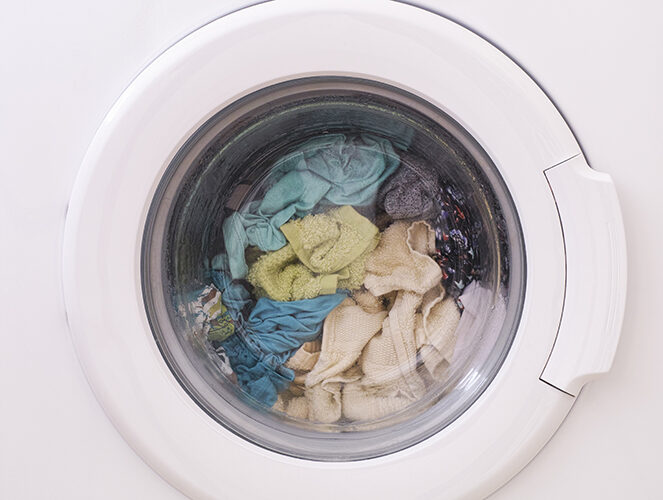Microplastics
A surprising source.

Microplastics are everywhere. Any plastic waste smaller than a pencil eraser is loosely defined as a microplastic. The smaller the plastic particles, the harder they are to sort out of waste streams. Microplastic particles can come from a plastic grocery bag that blows into a waterway and begins to disintegrate in the sun.
However, an enormous amount of microplastics are flowing into waterways from a surprising source: laundry. The quickly unraveling polymer fabrics are a significant microplastic source. How can we keep fashion out of our water?
According to a Nature.com report, clothes have become a main source of microplastics found throughout the world’s oceans, contributing roughly 35 percent to the global release of primary microplastics in these bodies of water. The average diameter of the microfibers found in the study ranged from 12 to 16 µm.
For context, these fabric plastics would be slightly smaller than the diameter of a strand of hair and slightly bigger than a red blood cell. Much smaller than a pencil eraser, it is incredibly difficult to separate these microplastic particles in wastewater treatment centers.
The smallest microplastics pass through treatment centers and end up in waterways. They will float or sink, settling into an ecosystem that didn’t evolve with plastics. This is a new problem for the earth.
From Waterways to the Bloodstream
According to the Science History Institute: “The first synthetic polymer was invented in 1869 by John Wesley Hyatt, who was inspired by a New York firm’s offer of $10,000 for anyone who could provide a substitute for ivory. The growing popularity of billiards had put a strain on the supply of natural ivory obtained through the slaughter of wild elephants.” Hyatt created a plastic substance that resembled ivory but could be shaped like clay.
Hundred-year-old elephant trunk knockoffs aren’t the widespread microplastic issue. If one of those ever made its way through the sewer system, it would be an easy item to sort out. It might be alarming to the person who found it, but it would be quickly separated.
In recent history, plastics have been used as substitutes for scarce metal and wood materials. Polymers could be tailored to applications, allowing for lightweight nylon fabrics and glass substitutes for airplane windows to become the norm.
Polymer products are built to last — that is the case for the polymers we use in the plumbing industry. The polymer components in a plumbing or heating system will reasonably outlast the modern building where they are installed. The use of durable polymer substitutes in everyday systems is not the problem — the issue is the explosion of disposable plastics.
The grocery stores and shopping malls we go to are not often selling plastics that will be passed down from generation to generation. Some of the plastics may end up in the waterways or landfills later on the day of purchase. The evolution of nylon from reusable parachute cord to seasonal fast fashion is a problem that outran our ability to properly dispose of the waste. We cannot sort out the tiniest remnants of synthetic fabrics effectively.
A 2022 Guardian article described a set of studies that found “microplastic pollution has been detected in human blood for the first time, with scientists finding the tiny particles in almost 80 [percent] of the people tested.”
The microplastic pollution problem is now bigger than a patch of garbage floating in the Pacific Ocean; the disposable plastic industry has become a new biological problem. We are still early in the medical research process of understanding the implications of microplastics within our cells.
Bio-based fabrics
It isn’t all doom and gloom. We can stop using so much quick-disintegrating clothing as a start. A Grist article described some innovative bio-based textiles that could make a difference. Your next shirt could be made of shrimp shells, mushrooms, apple mush or even lab-grown spider silk.
My initial reaction to a shrimp shirt is admittedly not great. I’ve smelled a dumpster full of day-old seafood before and don’t remember it fondly. However, this food-waste fabric has walked down the runways in New York, London and Paris in the last two years. Maybe an apple wallet is more my speed.
Silk protein built from “bacteria enhanced with a snippet of spider DNA” sounds better. It seems like something from an action movie and is probably an easier product to work with from a marketing perspective.
Are we overthinking this? What about only using cotton again? While cotton is a water-intensive plant, we could recycle cotton clothing. Natural Fiber Welding makes a wide variety of bio-based fabrics for a range of major manufacturers such as Patagonia, BMW, New Balance, Stella McCartney and most notably, H&M. I singled out H&M because its business model is fast fashion.
Unlike the seats in a BMW that will last decades, fast fashion contributes to clogging up the waterways by way of our washing machines.
Natural Fiber Welding follows three rules to evaluate potential materials:
• Use only natural ingredients that have been abundant on earth for millions of years.
• No synthetic toxins or plastics at any stage of manufacturing.
• Ensure materials can safely return to the earth at end-of-life.
These rules are an important set of considerations to turn the tide of plastic pollution.
We can reduce the stream of microplastics entering our food and water. Long-lifespan plastics are problem-solvers, with performance and longevity advantages over metal and wood materials. The quickly disintegrating synthetic plastic fabrics need to phase out.
From a potable water standpoint, we will get better at filtration and sorting these materials more effectively, but the best way to keep microplastics out of our blood might be to pay a few more dollars for a spider DNA-enhanced jacket.





